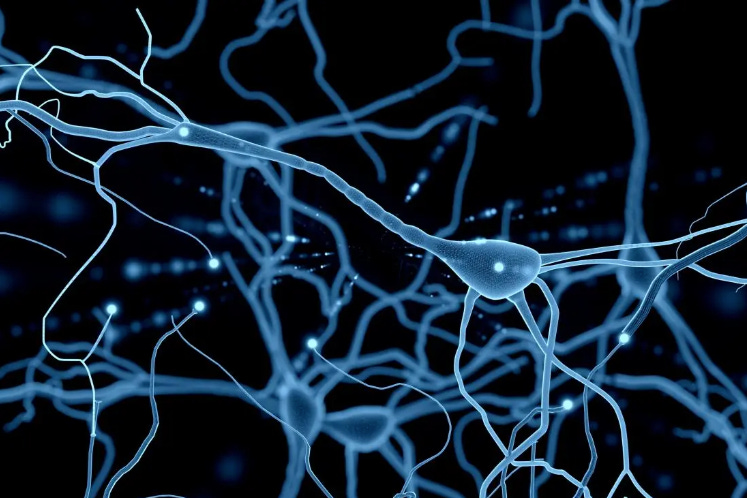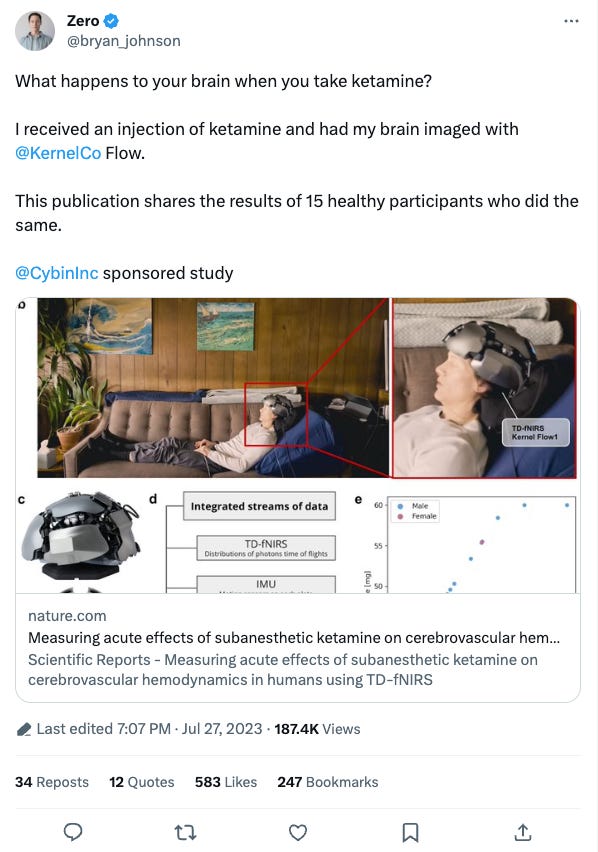Hi Friends,
Nina here. Each week I address topics on longevity, psychedelics and innovation suggested by you.
If you’re not a subscriber, here’s what you missed so far this month:
Subscribe to get every post delivered straight to your inbox every Wednesday.
Not seeing every Note in your inbox? It could be going to Spam 😢
Make sure to “mark as not spam” in your email client and move the email to your inbox
Add ninapatrick@substack.com to your contact list
Send an email to ninapatrick@substack.com
These steps can help your email client recognize your subscription to Nina’s Notes is not spam.
💬 In this note:
🧠 This is Your Brain on Ketamine
📚 A Court of Silver Flames
⚡️ Spaghettieis
🧠 This is Your Brain on Ketamine
Ketamine has been an FDA-approved medical anesthetic since 1970, and in the early 2000s a ground-breaking discovery was made about the antidepressant effects of ketamine.
Traditional antidepressants targeting the monoamine system (the neurotransmitters serotonin, noradrenaline and dopamine) can take weeks or even months to show effects.
Even worse, they don’t work for everyone and their efficacy has been questioned by some medical professionals.
Ketamine’s antidepressant effect can manifest in as little as 40 minutes. This rapid action has led to its classification as a Rapid Acting Antidepressant Drug (RAAD).
Ketamine is a non-competitive N-methyl-D-aspartate receptor antagonist, which predominantly affects the glutamatergic system which is involved in learning and memory.
This is different from traditional antidepressants, that act on the monoamine system which is responsible for emotion, arousal, and certain types of memory, and also different from the classic psychedelics that act on the serotonergic system which is critical for sleep, appetite and mood.
Regarding depression, research has indicated that large-scale brain networks are implicated in depressive symptomology and may be used as biomarkers for diagnosis and treatment optimisation.
To understand large-scale brain networks, you would need to complete neuroimaging studies which are both expensive and complex.
Typically MRIs, or magnetic resonance imaging, are used in these studies. The studies can only be conducted at a hospital or clinic where these expensive devices are installed. This limits the ability to run large studies and makes conducting large, longitudinal studies very difficult.
A large, longitudinal study, which covers a large group of people for a significant amount of time, is however needed to establish neural biomarkers that can diagnose and indicate effectiveness of treatment for depression and other mental health disorders. As MRIs are not a scalable solution, an alternative has been proposed.
That alternative is optical neuroimaging. Optical neuroimaging with functional near-infrared spectroscopy (fNIRS) has shown great potential to explore changes in brain activity.
In a recent proof of concept study published in Nature Scientific Reports, a neuroimaging technique called time-domain functional near-infrared spectroscopy (TD-fNIRS) was used to study the physiological effects of ketamine in humans.
The study used a novel, portable whole-head TD-fNIRS system called the Kernel Flow1.
Famous biohacker, tech mogul, longevity enthusiast and CEO of Kernel, Bryan Johnson, took part in the experiment. He is also the founder of Project Blueprint, an experiment to determine whether it’s possible to stay the same biological age. Read more on biological age versus chronological age and how to measure is in Nina’s Notes #8.
Fifteen healthy individuals participated in the study, which was not a study on the effects of ketamine for depression but rather a proof of concept for using Kernel Flow for psychedelic studies on patients with depression in the future. Therefore the study was not a clinical trial.
The participants completed four study visits in total. The first was a screening visit, then a dosing visit with a placebo, then a dosing visit with ketamine and finally a follow-up phone call.
Participants completed multiple surveys at different time points over the course of the study, to survey mystical experience, altered state of consciousness and dissociative state.The results indicated that ketamine alters states of consciousness and reduces depressive symptomatology.
Ketamine has known effects on cardiac signals such as heart rate and heart rate variability. The experiment used Kernel Flow to measure blood flow in the brain (cerebrovascular hemodynamics) and oxygenation. They found that ketamine affects the cardiovascular system and increases oxygenation. No difference in breathing rate was observed between placebo and ketamine dose.
The study also found that ketamine reduces the whole brain fractional amplitude of low-frequency fluctuations.The fractional amplitude of low-frequency fluctuations (fALFF) has been shown to correlate with brain metabolism and is a proxy for local neuronal activity.
Abnormal fALFF has been implicated in conditions like bipolar depression.
The study also claims that ketamine acutely reduces prefrontal global brain connectivity, when compared to placebo, which is different from previous fMRI studies which have shown ketamine increases in brain connectivity. It has been believed that increasing brain connectivity is like “rewiring” the brain which may be responsible for the reduction of symptoms of depression.
By using a combination of physiological (heart rate) and neural (fALFF) features along with answers to the Mystical Experience Questionnaire, a model was created which has the ability to predict the peak of a participant’s mystical experiences.
The study's primary goal was to demonstrate the potential of using fNIRS in clinical settings, and to demonstrate the use of the Kernel Flow device. While the results are interesting, it's essential to note that the study had limitations. For one, the sample size was too small, and secondly the participants were healthy volunteers, not actual patients with depression.
The simplicity of the TD-fNIRS in the Kernel Flow helmet may be an option to measure cortical function in longitudinal and large-scale studies in an out-patient setting, but more data is needed for a complete understanding of the impact of psychedelics on the brain.
📚 Book of the Week
A Court of Silver Flames by Sarah J. Maas
5 / 5 Stars
Book 5 of the A Court of Thorns and Roses series follows Nesta, the main character Feyre’s sister, and is definitely the hottest and steamiest book of the series so far. I’ve used this Instagram video too many dang times now but this book…is CRACK.
This is the last published book of the series…for now.
But don’t worry ACOTAR fans, there will be more! Book 6 has a scheduled release date in 2024, and a TBA date for Book 7.
⚡️ Check This Out
Behold, the Spaghettieis (pronounced “Spaghetti-ice”)
This unique German ice cream dish is created using a spaetzle maker to turn ice cream into pasta-like strands and then it’s topped with a fruit sauce and white chocolate to resemble marinara and parmesan.
This spaghetti ice cream, or “spaghettieis”, sells over 30 million cups each year.
Germans do love their ice cream.
The inventor, Dario Fontanella, unveiled his new creation at his ice cream shop, Eis Fontanella, in the 1970s and is still running the company today at 71 years old.
The spaghettieis catapulted his business to success. Fontanella now has multiple shops, selling spaghettieis, cakes, pastries, coffee and more than 200 flavors of ice cream, in addition to ice cream trucks and a factory for packaging all these sweet treats.






